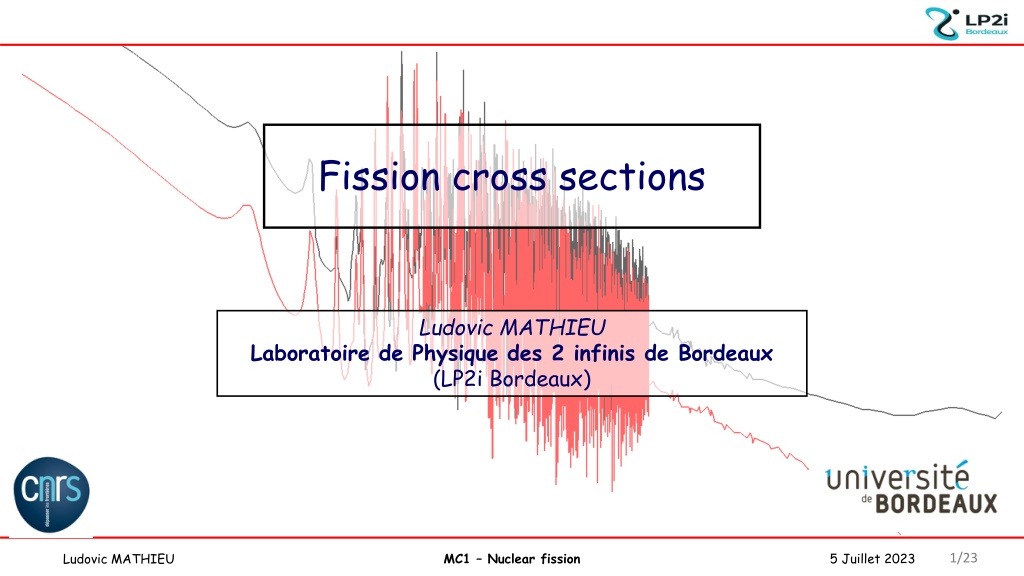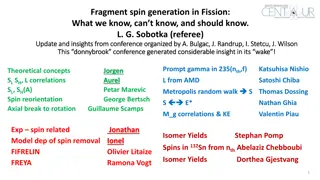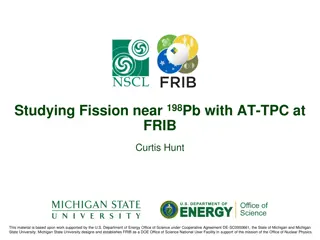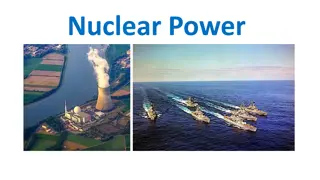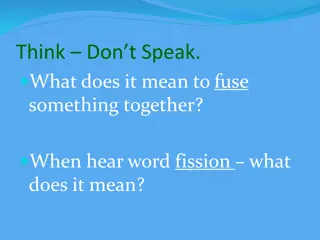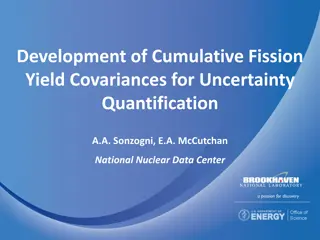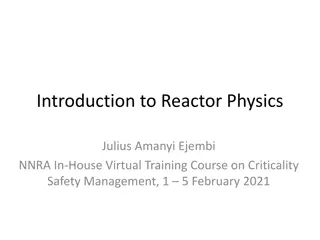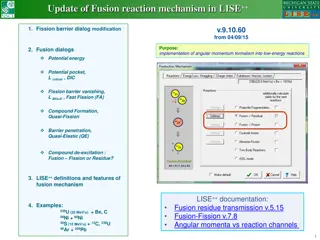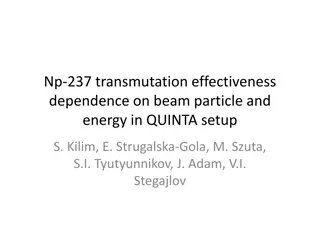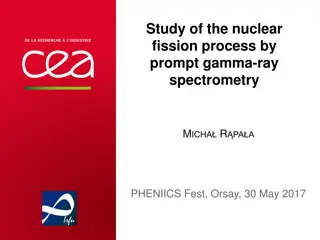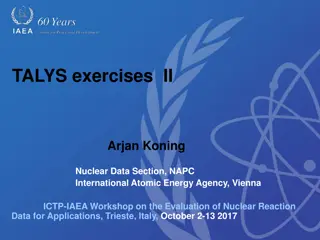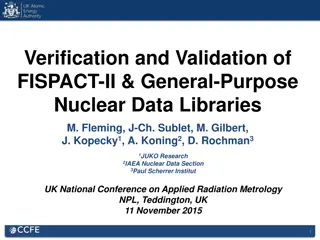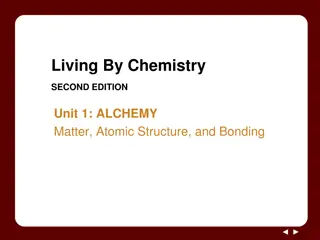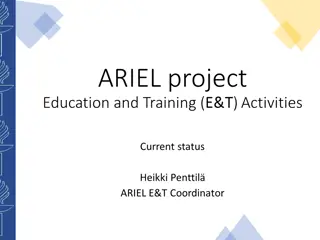Understanding Nuclear Fission Cross Sections
Nuclear fission cross sections play a crucial role in determining reaction rates in nuclear reactors and experiments. They represent the probability of nuclear interactions when neutrons collide with a nucleus, impacting fission and capture rates. These cross sections are influenced by factors such as isotope, neutron energy, and reaction type. Fissile and fertile nuclei exhibit different behaviors based on binding energy and fission barrier conditions, affecting their fission possibilities. The intricate properties of cross sections are vital for understanding nuclear reactions and reactor performance.
Download Presentation

Please find below an Image/Link to download the presentation.
The content on the website is provided AS IS for your information and personal use only. It may not be sold, licensed, or shared on other websites without obtaining consent from the author. Download presentation by click this link. If you encounter any issues during the download, it is possible that the publisher has removed the file from their server.
E N D
Presentation Transcript
Fission cross sections Ludovic MATHIEU Laboratoire de Physique des 2 infinis de Bordeaux (LP2i Bordeaux) MC1 Nuclear fission 5 Juillet 2023 Ludovic MATHIEU 1/23
I) Cross Section introduction Physical principles A cross section is linked to the probability of reaction Cross sections are mandatory to calculate reaction rates (fission rate, capture rate...) in nuclear reactors or physic experiment. Once the neutron interacts, the nucleus can decay into different channels: 10 fm 10-12cm Neutron impinging on this area (= cross section, aka XS) will interact with the nucleus In classical physic, the cross section equals the frontal area of the nucleus: ~ 10-24 cm The unit of cross section is then: 1 barn = 10-24 cm MC1 Nuclear fission 5 Juillet 2023 Ludovic MATHIEU 2/23
I) Cross Section introduction Physical principles In quantum physic, it depends on the nuclei nuclear structures and neutron energy. The XS can be larger or smaller than the nucleus area. For low slow neutrons : For epithermal neutrons, IF En corresponds exactly to an excited state: slow neutrons => large wave functions epithermal neutrons Very high XS for a precise En => resonance High XS because of wave-functions overlap A cross section is a complex property depending on : - isotope - neutron energy - reaction MC1 Nuclear fission 5 Juillet 2023 Ludovic MATHIEU 3/23
I) Cross Section introduction Example of Cross section Fission cross section of 235U, called 235U(n,f), is composed of several regimes: - Thermal part (no corresponding state) - Resolved Resonance Range (when the neutron energy corresponds to an existing state) - Unresolved Resonance Range (too many states to be resolved) - Continuum RRR Thermal part URR Continuum MC1 Nuclear fission 5 Juillet 2023 Ludovic MATHIEU 4/23
I) Cross Section introduction Fissile and fertile nuclei A fissile nucleus can undergo fission when impinged by a thermal neutron Comparison between binding energy and fission barrier: - binding energy > fission barrier => fissile - binding energy < fission barrier => fertile Additional kinetic energy => fission becomes possible 235U(n,f) Enough energy to fission Due to pairing effect, half of nuclei are fissile, and half are fertile: - fissile: 233,235U, 239,241Pu - fertile : 232Th, 234,236,238U, 240,242Pu 238U(n,f) Only sub-barrier fission (tunnel effect) . MC1 Nuclear fission 5 Juillet 2023 Ludovic MATHIEU 5/23
II) Cross Section data Existing data Cross sections are measured since the beginning of nuclear science. as well for fission... 243Am(n,f) 238U(n,f) 239Pu(n,f) 233U(n,f) 243Cm(n,f) 235U(n,f) 234U(n,f) But all these are not experimental data 56Fe(n, ) 235U(n, ) et (n,2n) 232Th(n,n) et (n, ) than for other reactions... 208Pb(n,n) MC1 Nuclear fission 5 Juillet 2023 Ludovic MATHIEU 6/23
II) Cross Section data Experimental data The extensive experimental data are compiled in databases, but cannot be used directly . A simple average is not the true cross section value. The more precise the experimental data, the closer they are from the true value. However, measurements are not enough... MC1 Nuclear fission 5 Juillet 2023 Ludovic MATHIEU 7/23
II) Cross Section data Evaluations Theoretical calculations with models are carried out to re-create the cross sections Physical ingredients and models depends on the energy range considered (thermal range, resonance range, continuum...) Some experimental data may be difficult to reproduce (unknown phenomenon) The agreement between evaluations and with experimental data may vary Different choices are made by evaluators => different evaluations Experimental data are investigated to check their consistency and looking for their bias. Evaluators require high quality and highly accurate experimental data(including uncertainties, covariances, experimental parameters...) . MC1 Nuclear fission 5 Juillet 2023 Ludovic MATHIEU 8/23
III) Measurement principles Back to basic The measurement of a neutron-induced reaction cross section requires : 1- a sample to be irradiated by neutrons 2- a way to detect the expected reactions 3- a way to produce neutrons sample ? neutrons detector 1- Fission cross section are mainly measured for actinides radioactive target (uranium isotopes, plutonium isotopes, etc.). This has consequences : - on the experimental setup - on the administrative paper work and delays MC1 Nuclear fission 5 Juillet 2023 Ludovic MATHIEU 9/23
III) Measurement principles 2- Fission detection Fission process emits: - two Fission Fragments with high energy (few 10 MeV each) - several -rays (6-8 in average) - several neutrons (2-3 in average) Easiest way: - exactly two FF - charged particle (high detection efficiency) - no background Usual detector: a fission chamber Principle: - FF create e-/hole pair in a gas - charge drift thanks to an electric field - signal collection Properties: - possibly compact - high efficiency - radiation resistant (gas) G. de Izarra, Eur. Phys. J. Conf. 225 (1):10003 MC1 Nuclear fission 5 Juillet 2023 Ludovic MATHIEU 10/23
III) Measurement principles 2- Fission detection Fission process emits: - two Fission Fragments with high energy (few 10 MeV each) - several -rays (6-8 in average) - several neutrons (2-3 in average) Easiest way: - exactly two FF - charged particle (high detection efficiency) - no background Other detectors: Parallel Plate Avalanche Counter: - provides FF positions - radiation resistant Silicon detector: - easy to use - 100% efficient - not radiation resistant Solar cells - easy to use - radiation resistant and others... The detector used is adapted to experiment constraints. MC1 Nuclear fission 5 Juillet 2023 Ludovic MATHIEU 11/23
III) Measurement principles 3- Neutron production No isolated neutron exists in nature. They have to be produced with nuclear reactions : 7Li(p,n), D(d,n), T(p,n), T(d,n), 7Be( ,n), 238U( ,n), ... target neutrons En depends on the angle => for a given angle, quasi-monoenergetic neutrons beam This production method: - is quite simple - produces quasi-monoenergetic neutrons - is applicable for En > few 100 keV Cross section are then measured at specific neutron energies and only at high energy. MC1 Nuclear fission 5 Juillet 2023 Ludovic MATHIEU 12/23
III) Measurement principles 3- Neutron production No isolated neutron exists in nature. They have to be produced with nuclear reactions : 7Li(p,n), D(d,n), T(p,n), T(d,n), 7Be( ,n), 238U( ,n), ... A completely different technique can be used: Time of Flight (ToF) neutron source t1 : high E thermalizer irradiated target t2 : medium E t3 : low E t4 : very low E pulsation ! ToF technic enables the different energies to be disentangled The cross section can be measured for a lot of different neutron energies simultaneously . MC1 Nuclear fission 5 Juillet 2023 Ludovic MATHIEU 13/23
Conclusion Physical principles Neutron induced cross sections are related to the ability of the nucleus to absorb the neutron and decay in a given reaction channel They are mandatory to calculate reaction rates Cross section data Cross section have been measured for several decades and a large amount of data have already been gathered The evaluation process is crucial to obtain usable cross section from experimental data This process need high quality and highly accurate data Measurement principles 1- sample to irradiate: all fission samples are radioactive 2- fission detector: usually a ionisation chamber but a large diversity exists 3- neutron source: . charge particle induced nuclear reaction . the Time of Flight technique enables to obtain all energy at once MC1 Nuclear fission 5 Juillet 2023 Ludovic MATHIEU 14/23
Merci de votre attention MC1 Nuclear fission 5 Juillet 2023 Ludovic MATHIEU 15/23
